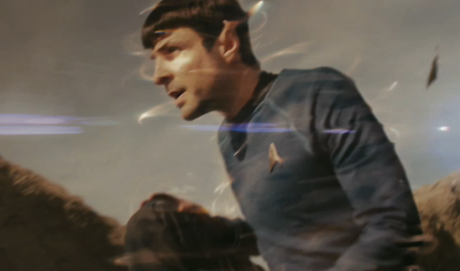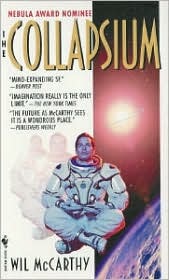Making Star Trek Possible: 5 methods for non-quantum teleportation
Posted by Andrew on May 4th, 2009A five-part series that tries to explain how to make the science of Star Trek real…

The transporters in Star Trek are an exciting concept. Recent developments in quantum physics have made the possibility of teleporting matter a theoretical possibility while warp drive still remains a fantasy concept. However, the amount of energy required to move a person and all the other problems that go with it (engineering and ethical) leave quantum teleportation a bit to be desired for practical use. Crazy things can happen, but in the event that quantum teleportation doesn’t scale up or people are upset by the idea of their atoms being destroyed so copies can take their place, here are some slightly (we think) more practical solutions for teleportation that use way less energy and preserve your atoms:
#1 The Human Javelin
If your goal is to get down to a planet as quickly as possible in an intact condition and you don’t mind what happens to your body in the interim, it might be possible using nanotechnology to squish you into a very small and narrow package. Basically your whole body would be dissected and shoved into a tube with a very narrow diameter (centimeters) and shot at the planet. Once the torpedo arrives, the nanobots that make up the packing material would go to work reassembling you from your squished up parts.
As unpleasant as this sounds, it’s really not that different from flying coach on most domestic airlines.
Technology required: An understanding of how to use nanotechnology to disassemble living systems and then put them back together in living condition.
Probability of being capable of this in the next 100 years: HIGH
#2 The Swarm
Slightly more elegant than the human torpedo but no less damaging to the short-term integrity of your molecules, is the idea of the Human Swarm. Imagine several million nano-mosquitoes each taking a tiny bite out of you – but remembering where it all went. They would then be shot out of your ship at a planet where they would drift down to the surface as a swarm. Once there, they’d begin to reassemble you back into your original form following an instruction set they made when they took you apart.

The elegant part about this solution is that it would look like some form of matter transporter technology or the smoke monster from Lost…
Technology required: The whole putting living things back together nano thing and intelligent flying nanobots.
Probability of being capable of this in the next 100 years: HIGH
#3 The Human Fax
If having your molecules diced up and transported elsewhere doesn’t appeal to you, an alternative is stepping into a machine that makes a copy of you somewhere else. This copy goes about its business (trade shows, Comic-Con, Lunar Vegas, etc) then steps back into the machine at the other end, downloads its experiences back to you and is disassembled. You then come out of your origin booth with the experience of having traveled somewhere at the speed of light and then back.

Forms of this idea have appeared in various sci-fi novels (Asimov’s Norby series and Wil McCarthy’s The Collapsium for example). It’s a very practical solution and may not require technology quite as advanced as the others suggested here. In fact, the faxed version of you doesn’t even have to be a precise copy. It just has to be capable of acting like you and recording what you do. The next step is getting those experiences back into your head. If you’re comfortable with only a downstream link back into your head, the experiences could be sent back in real time. Time delay wouldn’t be a problem because you’re only observing what your avatar does.
Technology required: The ability to electronically transmit experiences into a brain (actually closer than we thought just a few years ago). For long distances: AI driven avatars that can act like us – or digitally produced clones. For short distances: lifelike robot versions of ourselves to transmit experiences back to us.
Probability of being capable of this in the next 100 years: HIGH
#4 Particle Beam Teleportation
If all you want is to get your atoms from one place to another as quickly as possible, a particle beam can do the trick right now. Atom by atom you can flick your bits against a far wall using very high voltages and some electromagnets. The hard part is putting it all together again.

In a secret laboratory right now there might be some project sitting on a lab table that is trying to do this at least in part. The answer might be using two particle beams that intersect at a point and can move objects like forceps. These beams would sweep over you and shoot your particles somewhere in a matter stream where they would be stitched back together.
Technology required: Matter beams that can disassemble you atom by atom. A way to use particle beams or lasers to align and reassemble particles.
Probability of being capable of this in the next 100 years: MEDIUM
#5 Some exotic idea
World-changing ideas are often in obscurity before they change everything. Incandescent lights, silicon semi-conductors and even the Internet were academic concepts before they found their earth-shattering applications. There might be some theory or phenomenon sitting in a journal right now that some kid is going to base her graduate thesis on and create a great cover story for Discover magazine which might then lead to some radical new approach. Bose-Einstein Condensate fields?
Maybe we can move matter like light. Maybe you can make a matter hologram that allows you to reduce it to two dimensions and project it elsewhere. Maybe you can project all of the physical aspects of matter while keeping the atoms somewhere else. The point is, there are a lot of possibilities if you start thinking about the solution outside of just worm holes and a quantum teleportation.
May 4th, 2009 at 9:46 am
You guys really need to check your facts. Willy Wonka has been doing it with children since 1971 and I saw David Copperfield do it in Las Vegas once. Sent some boy from the audience to Hawaii.
Jeesh!
May 4th, 2009 at 12:53 pm
I'm going to start trying this on my cats. I'll let you know my results!
May 4th, 2009 at 6:37 pm
I think Andrew could pass for young Spock, but he'd have to put his ears in a pencil sharpener.
May 4th, 2009 at 11:37 pm
I think Andrew could pass for young Spock, but he'd have to put his ears in a pencil sharpener.